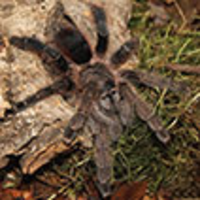- Joined
- Feb 28, 2011
- Messages
- 953

Not something you see every day and stunning photos!Avicularia merianae
Mom w/sac
View attachment 361807
Sac w/ First Instars View attachment 361808
First Instars / Pre-Molt
View attachment 361809
Second Instars
View attachment 361810
It is very similar to Avik Metallica. Can I take a photo of your hind legs?Avic avic.
Her enclosure is on a shelf by the kitchen table.
She was hanging out watching us eat breakfast this morning.
Lookin' cute.
And how can we confirm that this is the morphotype of the SP.Amazonica Manaus?Avicularia variegata • Morphotype #1
[(Hobby sp. "Amazonica")] • Manaus, Brazil
2nd Instar • Post Molt
View attachment 362726
I'm camera shy but if you really want I will model for you.It is very similar to Avik Metallica. Can I take a photo of your hind legs?
How do we confirm anything Avicularia? By interpreting the revision, of course.And how can we confirm that this is the morphotype of the SP.Amazonica Manaus?
I would be grateful to you for the photo of AV.Metallica. I am not an Englishman,I translate with an interpreter,if there are any mistakes,I apologize.I'm camera shy but if you really want I will model for you.
Do you have a photo? That it was possible to distinguish between them? They wrote it seems to be good,but if there are no photos,then how can you distinguish them? Here is my AV.SP. Amazonica Manaus BrazilHow do we confirm anything Avicularia? By interpreting the revision, of course.Hey... If you agree these are variegata then hobby sp. Amazonica from Manaus, Brazil has to be morphotype #1.
They were collected in the same locality, fit the description exactly and the pictures illustrated in the revision are absolutely identical to only morphotype #1.
Description of the morphotypes from revision:
"Variation:
All examined specimens of A. variegata stat. n. have grizzled setae on palps and legs (except those found in Venezuela), but with slight differences in body coloration. We detected three morphotypes. Morphotype 1 is found especially near Manaus (Fig. 77) and females have carapace, legs, and palps with greyish short body setae with very intense green sheen and whitish leg rings (Fig. 70). Abdomen has vivid reddish guard-setae grouped on lateral and dorsal anterior areas, black short body setae and venter velvety black. Males have black abdomen with some whitish tipped setae homogeneously distributed (Fig. 71). Morphotype 2 is found in same area (Fig. 77), but has overall greyish coloration, with short body setae with discrete green sheen and yellowish leg rings. Females have abdomen with light brown guard-setae grouped on lateral and dorsal anterior areas, black short body setae, and venter dark brown (Fig. 74). Males are very similar to morphotype 1 but with yellowish rings (Fig. 75). Males from Puerto Ayacucho (AMNH Ve29) and from Caripito (AMNH Ve31), Venezuela, have genitalia and legs with proportions compatible with those from Brazil, as well as whitish leg rings. However, they do not have white tipped hairs on legs and abdomen as specimens of A. variegata stat. n. from Manaus, Brazil (Fig. 77), and the prominence on palpal bulb is not well-developed as in specimens from Manaus (morphotype 1). The juvenile female AMNH Ve21, also from Venezuela, has short body setae with golden sheen and very discrete white tipped setae in legs and palps as well as whitish rings. We prefer not to consider these forms as separate species because these slight differences can be due to populational variation since the specimens were collected in the northern limit of the species distribution. It is here called morphotype 3. Despite being collected in Caracas, also in the northern limit of the species, the specimen AMNH Ve18 seems to be a typical morphotype 1. It is necessary to examine more material to understand morphological variation and species boundaries of Venezuelan Avicularia."

